Assessment of Future Rainfall Quantile Changes in South Korea Based on a CMIP6 Multi-Model Ensemble
Abstract
:1. Introduction
2. Methodology
2.1. Study Area
2.2. Datasets
2.3. Bias Correction
2.4. Regional Frequency Analysis
2.5. Performance Evaluation
2.5.1. Root Mean Square Error (RMSE)
2.5.2. Percent Bias (Pbias)
2.5.3. Coefficient of Determination (R2)
3. Results
3.1. Historical Verification
3.2. Uncertainty Analysis
3.3. Future Changes for Monthly and Annual Rainfall
3.4. Future Rainfall Quantile Changes
3.5. Spatial Analysis of Rainfall Data
4. Discussion
5. Conclusions
- (1)
- HIST data have validated the efficacy of the SQM bias correction technique, which has been shown to significantly mitigate model bias. Notable reductions in RMSE and Pbias and enhancements in R2 values underscore the robustness of the SQM method for the correction of climate models.
- (2)
- Model uncertainty has been identified as a significant factor influencing climate projections in both the short- and mid-term. Furthermore, in the long-term, scenario uncertainty and internal variability have emerged as increasingly important contributors to the overall uncertainty associated with climate forecasts. This shift underscores the growing significance of emission scenarios in the realm of long-term climate change projections.
- (3)
- An analysis of monthly precipitation patterns revealed progressively larger increases, transitioning from moderate near-term changes to substantial anomalies in the far-term period, particularly under the high-emission scenario (SSP585). The significant increases in monthly precipitation underscore the sensitivity of precipitation patterns to elevated greenhouse gas concentrations.
- (4)
- Annual precipitation has demonstrated a consistent upward trend across all scenarios and future timeframes, with the most significant increases occurring under SSP585 as the century draws to a close. Furthermore, the observed rise in year-to-year variability presents future challenges for the management of water resources.
- (5)
- Projections indicate that future rainfall quantiles are expected to increase progressively, particularly under high-emission scenarios. Significant regional variability has been observed, especially in central and southern South Korea, as well as along the eastern coastline. These spatial discrepancies reflect the influences of atmospheric circulation, the Asian summer monsoon, and local topographical features.
Author Contributions
Funding
Data Availability Statement
Acknowledgments
Conflicts of Interest
Abbreviations
| CDF | cumulative distribution function |
| GCMs | global climate models |
| GEV | Generalized Extreme Value |
| IFM | Index Flood Methodology |
| Pbias | percent bias |
| probability density function | |
| RCP | representative concentration pathway |
| RFA | regional frequency analysis |
| RMSE | root mean square error |
| R2 | coefficient of determination |
| S0 | historical period (1985–2014) |
| S1 | near-term (2015–2044) |
| S2 | mid-term (2043–2072) |
| S3 | far-term (2071–2100) |
| SSP | shared socioeconomic pathways |
| SQM | statistical quantile mapping |
References
- de Vries, I.; Sippel, S.; Zeder, J.; Fischer, E.; Knutti, R. Increasing extreme precipitation variability plays a key role in future record-shattering event probability. Commun. Earth Environ. 2024, 5, 482. [Google Scholar] [CrossRef] [PubMed]
- Fowler, H.J.; Lenderink, G.; Prein, A.F.; Westra, S.; Allan, R.P.; Ban, N.; Barbero, R.; Berg, P.; Blenkinsop, S.; Do, H.X.; et al. Anthropogenic intensification of short-duration rainfall extremes. Nat. Rev. Earth Environ. 2021, 2, 107–122. [Google Scholar] [CrossRef]
- Jung, I.W.; Bae, D.H.; Lee, B.J. Possible change in Korean streamflow seasonality based on multi-model climate projections. Hydrol. Process. 2013, 27, 1033–1045. [Google Scholar] [CrossRef]
- Cha, D.H.; Lee, D.K.; Jin, C.S.; Kim, G.; Choi, Y.; Suh, M.-S.; Ahn, J.-B.; Hong, S.-Y.; Min, S.-K.; Park, S.-C.; et al. Future changes in summer precipitation in regional climate simulations over the Korean Peninsula forced by multi-RCP scenarios of HadGEM2-AO. Asia-Pac. J. Atmos. Sci. 2016, 52, 139–149. [Google Scholar] [CrossRef]
- Park, C.; Son, S.-W.; Kim, H.; Ham, Y.-G.; Kim, J.; Cha, D.-H.; Chang, E.-C.; Lee, G.W.; Kug, J.-S.; Lee, W.-S.; et al. Record-breaking summer rainfall in South Korea in 2020: Synoptic characteristics and the role of large-scale circulations. Mon. Weather Rev. 2021, 149, 3085–3100. [Google Scholar] [CrossRef]
- Kim, S.; Park, J.H.; Kug, J.S. Tropical origins of the record-breaking 2020 summer rainfall extremes in East Asia. Sci. Rep. 2022, 12, 5366. [Google Scholar] [CrossRef] [PubMed]
- Park, C.; Min, S.K.; Lee, D.; Cha, D.-H.; Suh, M.-S.; Kang, H.-S.; Hong, S.-Y.; Lee, D.-K.; Baek, H.-J.; Boo, K.-O.; et al. Evaluation of multiple regional climate models for summer climate extremes over East Asia. Clim. Dyn. 2016, 46, 2469–2486. [Google Scholar] [CrossRef]
- Salas, J.D.; Obeysekera, J.; Vogel, R.M. Techniques for assessing water infrastructure for nonstationary extreme events: A review. Hydrol. Sci. J. 2018, 63, 325–352. [Google Scholar] [CrossRef]
- Cheng, L.; AghaKouchak, A. Nonstationary precipitation intensity–duration–frequency curves for infrastructure design in a changing climate. Sci. Rep. 2014, 4, 7093. [Google Scholar] [CrossRef]
- Lim, G.-K.; Kim, B.-S.; Lee, B.-H.; Jeung, S.-J. Effect of climate change on annual precipitation in Korea using data screening techniques and climate change scenarios. Atmosphere 2020, 11, 1027. [Google Scholar] [CrossRef]
- Wang, G.; Wang, D.; Trenberth, K.E.; Erfanian, A.; Yu, M.; Bosilovich, M.G.; Parr, D.T. The peak structure and future changes of the relationships between extreme precipitation and temperature. Nat. Clim. Chang. 2017, 7, 268–274. [Google Scholar] [CrossRef]
- Sillmann, J.; Kharin, V.V.; Zwiers, F.W.; Zhang, X.; Bronaugh, D. Climate extremes indices in the CMIP5 multimodel ensemble: Part 2. Future climate projections. J. Geophys. Res. Atmos. 2013, 118, 2473–2493. [Google Scholar] [CrossRef]
- Sperber, K.R.; Annamalai, H.; Kang, I.-S.; Kitoh, A.; Moise, A.; Turner, A.; Wang, B.; Zhou, T. The Asian summer monsoon: An intercomparison of CMIP5 vs. CMIP3 simulations of the late 20th century. Clim. Dyn. 2013, 41, 2711–2744. [Google Scholar] [CrossRef]
- Wang, B.; Liu, J.; Kim, H.-J.; Webster, P.J.; Yim, S.-Y. Recent change of the global monsoon precipitation (1979–2008). Clim. Dyn. 2012, 39, 1123–1135. [Google Scholar] [CrossRef]
- Eyring, V.; Bony, S.; Meehl, G.A.; Senior, C.A.; Stevens, B.; Stouffer, R.J.; Taylor, K.E. Overview of the Coupled Model Intercomparison Project Phase 6 (CMIP6) experimental design and organization. Geosci. Model Dev. 2016, 9, 1937–1958. [Google Scholar] [CrossRef]
- Adelodun, B.; Ahmad, M.J.; Odey, G.; Adeyi, Q.; Choi, K.S. Performance-based evaluation of CMIP5 and CMIP6 global climate models and their multi-model ensembles to simulate and project seasonal and annual climate variables in the Chungcheong region of South Korea. Atmosphere 2023, 14, 1569. [Google Scholar] [CrossRef]
- Shin, Y.; Shin, Y.; Hong, J.; Kim, M.-K.; Byun, Y.-H.; Boo, K.-O.; Chung, I.-U.; Park, D.-S.R.; Park, J.-S. Future Projections and Uncertainty Assessment of Precipitation Extremes in the Korean Peninsula from the CMIP6 Ensemble with a Statistical Framework. Atmosphere 2021, 12, 97. [Google Scholar] [CrossRef]
- Chen, Z.; Zhou, T.; Zhang, L.; Chen, X.; Zhang, W.; Jiang, J. Global land monsoon precipitation changes in CMIP6 projections. Geophys. Res. Lett. 2020, 47, e2019GL086902. [Google Scholar] [CrossRef]
- Kim, Y.H.; Min, S.K.; Zhang, X.; Sillmann, J.; Sandstad, M. Evaluation of the CMIP6 multi-model ensemble for climate extreme indices. Weather Clim. Extremes 2020, 29, 100269. [Google Scholar] [CrossRef]
- Korea Meteorological Administration (KMA). Annual Climatological Report; KMA: Seoul, Republic of Korea, 2023.
- Beck, H.E.; Zimmermann, N.E.; McVicar, T.R.; Vergopolan, N.; Berg, A.; Wood, E.F. Present and future Köppen–Geiger climate classification maps at 1-km resolution. Sci. Data 2018, 5, 180214. [Google Scholar] [CrossRef]
- Chough, S.K.; Ree, J.H.; Choi, D.K.; Yoon, S.H. Tectonic and sedimentary evolution of the Korean peninsula: A review and new view. Earth-Sci. Rev. 2000, 52, 175–235. [Google Scholar] [CrossRef]
- Water Resources Management Information System (WAMIS). Available online: http://www.wamis.go.kr (accessed on 19 March 2025).
- Bi, D.; Dix, M.; Marsland, S.; O’Farrell, S.; Sullivan, A.; Bodman, R.; Law, R.; Harman, I.; Srbinovsky, J.; Rashid, H.A.; et al. Configuration and spin-up of ACCESS-CM2, the new generation Australian Community Climate and Earth System Simulator coupled model. J. South. Hemisph. Earth Syst. Sci. 2020, 70, 225–251. [Google Scholar] [CrossRef]
- Ziehn, T.; Chamberlain, M.A.; Law, R.M.; Lenton, A.; Bodman, R.W.; Dix, M.; Stevens, L.; Wang, Y.P.; Srbinovsky, J. The Australian Earth System Model: ACCESS-ESM1.5. J. South. Hemisph. Earth Syst. Sci. 2020, 70, 193–214. [Google Scholar] [CrossRef]
- Semmler, T.; Danilov, S.; Gierz, P.; Goessling, H.F.; Hegewald, J.; Hinrichs, C.; Koldunov, N.; Khosravi, N.; Mu, L.; Rackow, T.; et al. Simulations for CMIP6 with the AWI Climate Model AWI-CM-1-1. J. Adv. Model. Earth Syst. 2020, 12, e2019MS002009. [Google Scholar] [CrossRef]
- Wu, T.; Lu, Y.; Fang, Y.; Xin, X.; Li, L.; Li, W.; Jie, W.; Zhang, J.; Liu, Y.; Zhang, L.; et al. The Beijing Climate Center Climate System Model (BCC-CSM): The main progress from CMIP5 to CMIP6. Geosci. Model Dev. 2019, 12, 1573–1600. [Google Scholar] [CrossRef]
- Swart, N.C.; Cole, J.N.S.; Kharin, V.V.; Lazare, M.; Scinocca, J.F.; Gillett, N.P.; Anstey, J.; Arora, V.; Christian, J.R.; Hanna, S.; et al. The Canadian Earth System Model version 5 (CanESM5.0.3). Geosci. Model Dev. 2019, 12, 4823–4873. [Google Scholar] [CrossRef]
- Cherchi, A.; Fogli, P.G.; Lovato, T.; Peano, D.; Iovino, D.; Gualdi, S.; Masina, S.; Scoccimarro, E.; Materia, S.; Bellucci, A.; et al. Global mean climate and main patterns of variability in the CMCC-CM2 coupled model. J. Adv. Model. Earth Syst. 2019, 11, 185–209. [Google Scholar] [CrossRef]
- Lovato, T.; Peano, D.; Butenschön, M.; Materia, S.; Iovino, D.; Scoccimarro, E.; Fogli, P.G.; Cherchi, A.; Bellucci, A.; Gualdi, S.; et al. CMIP6 simulations with the CMCC Earth System Model (CMCC-ESM2). J. Adv. Model. Earth Syst. 2022, 14, e2021MS002814. [Google Scholar] [CrossRef]
- Wyser, K.; van Noije, T.; Yang, S.; von Hardenberg, J.; O’Donnell, D.; Döscher, R. On the increased climate sensitivity in the EC-Earth model from CMIP5 to CMIP6. Geosci. Model Dev. 2020, 13, 3465–3474. [Google Scholar] [CrossRef]
- Döscher, R.; Acosta, M.; Alessandri, A.; Anthoni, P.; Arsouze, T.; Bergman, T.; Bernardello, R.; Boussetta, S.; Caron, L.-P.; Carver, G.; et al. The EC-Earth3 Earth system model for the Coupled Model Intercomparison Project 6. Geosci. Model Dev. 2022, 15, 2973–3020. [Google Scholar] [CrossRef]
- Li, L.; Yu, Y.; Tang, Y.; Lin, P.; Xie, J.; Song, M.; Dong, L.; Zhou, T.; Liu, L.; Wang, L.; et al. The flexible global ocean–atmosphere–land system model grid-point version 3 (fgoals-g3): Description and evaluation. J. Adv. Model. Earth Syst. 2020, 12, e2019MS002012. [Google Scholar] [CrossRef]
- Held, I.M.; Guo, H.; Adcroft, A.; Dunne, J.P.; Horowitz, L.W.; Krasting, J.; Shevliakova, E.; Winton, M.; Zhao, M.; Bushuk, M.; et al. Structure and performance of GFDL’s CM4.0 climate model. J. Adv. Model. Earth Syst. 2019, 11, 3691–3727. [Google Scholar] [CrossRef]
- Swapna, P.; Krishnan, R.; Sandeep, N.; Prajeesh, A.G.; Ayantika, D.C.; Manmeet, S.; Vellore, R. Long-term climate simulations using the IITM Earth System Model (IITM-ESMv2) with focus on the South Asian monsoon. J. Adv. Model. Earth Syst. 2018, 10, 1127–1149. [Google Scholar] [CrossRef]
- Volodin, E.M.; Mortikov, E.V.; Kostrykin, S.V.; Galin, V.Y.; Lykossov, V.N.; Gritsun, A.S.; Diansky, N.A.; Gusev, A.V.; Iakovlev, N.G.; Shestakova, A.A.; et al. Simulation of the modern climate using the INM-CM48 climate model. Russ. J. Numer. Anal. Math. Model. 2018, 33, 367–374. [Google Scholar] [CrossRef]
- Volodin, E.M.; Mortikov, E.V.; Kostrykin, S.V.; Galin, V.Y.; Lykossov, V.N.; Gritsun, A.S.; Diansky, N.A.; Gusev, A.V.; Iakovlev, N.G. Simulation of the present-day climate with the climate model INMCM5. Clim. Dyn. 2017, 49, 3715–3734. [Google Scholar] [CrossRef]
- Lurton, T.; Balkanski, Y.; Bastrikov, V.; Bekki, S.; Bopp, L.; Braconnot, P.; Brockmann, P.; Cadule, P.; Contoux, C.; Cozic, A.; et al. Implementation of the CMIP6 forcing data in the IPSL-CM6A-LR model. J. Adv. Model. Earth Syst. 2020, 12, e2019MS001940. [Google Scholar] [CrossRef]
- Lee, J.; Kim, J.; Sun, M.-A.; Kim, B.-H.; Moon, H.; Sung, H.M.; Kim, J.; Byun, Y.-H. Evaluation of the Korea Meteorological Administration Advanced Community Earth-System model (K-ACE). Asia-Pac. J. Atmos. Sci. 2020, 56, 381–395. [Google Scholar] [CrossRef]
- Tatebe, H.; Ogura, T.; Nitta, T.; Komuro, Y.; Ogochi, K.; Takemura, T.; Sudo, K.; Sekiguchi, M.; Abe, M.; Saito, F.; et al. Description and basic evaluation of simulated mean state, internal variability, and climate sensitivity in MIROC6. Geosci. Model Dev. 2019, 12, 2727–2765. [Google Scholar] [CrossRef]
- Gutjahr, O.; Putrasahan, D.; Lohmann, K.; Jungclaus, J.H.; von Storch, J.-S.; Brüggemann, N.; Haak, H.; Stössel, A. Max Planck Institute Earth System Model (MPI-ESM1.2) for the High-Resolution Model Intercomparison Project (HighResMIP). Geosci. Model Dev. 2019, 12, 3241–3281. [Google Scholar] [CrossRef]
- Mauritsen, T.; Bader, J.; Becker, T.; Behrens, J.; Bittner, M.; Brokopf, R.; Brovkin, V.; Claussen, M.; Crueger, T.; Esch, M.; et al. Developments in the MPI-M Earth System Model version 1.2 (MPI-ESM1.2) and its response to increasing CO2. J. Adv. Model. Earth Syst. 2019, 11, 998–1038. [Google Scholar] [CrossRef]
- Yukimoto, S.; Kawai, H.; Koshiro, T.; Oshima, N.; Yoshida, K.; Urakawa, S.; Tsujino, H.; Deushi, M.; Tanaka, T.; Hosaka, M.; et al. The Meteorological Research Institute Earth System Model Version 2.0, MRI-ESM2.0: Description and basic evaluation of the physical component. J. Meteorol. Soc. Jpn. Ser. II 2019, 97, 931–965. [Google Scholar] [CrossRef]
- Seland, Ø.; Bentsen, M.; Olivié, D.; Toniazzo, T.; Gjermundsen, A.; Graff, L.S.; Debernard, J.B.; Gupta, A.K.; He, Y.-C.; Kirkevåg, A.; et al. Overview of the Norwegian Earth System Model (NorESM2) and key climate response of CMIP6 DECK, historical, and scenario simulations. Geosci. Model Dev. 2020, 13, 6165–6200. [Google Scholar] [CrossRef]
- Lee, W.-L.; Wang, Y.-C.; Shiu, C.-J.; Tsai, I.-C.; Tu, C.-Y.; Lan, Y.-Y.; Chen, J.-P.; Pan, H.-L.; Hsu, H.-H. Taiwan Earth System Model Version 1: Description and evaluation of mean state. Geosci. Model Dev. 2020, 13, 3887–3904. [Google Scholar] [CrossRef]
- Cho, J.; Jung, I.; Cho, W.; Hwang, S. User-Centered Climate Change Scenarios Technique Development and Application of Korean Peninsula. J. Clim. Chang. Res. 2018, 9, 13–29. [Google Scholar] [CrossRef]
- Gudmundsson, L.; Bremnes, J.B.; Haugen, J.E.; Engen-Skaugen, T. Technical Note: Downscaling RCM Precipitation to the Station Scale Using Statistical Transformations—A Comparison of Methods. Hydrol. Earth Syst. Sci. 2012, 16, 3383–3390. [Google Scholar] [CrossRef]
- Cho, J.; Ko, G.; Kim, K.; Oh, C. Climate Change Impacts on Agricultural Drought with Consideration of Uncertainty in CMIP5 Scenarios. Irrig. Drain. 2016, 65, 7–15. [Google Scholar] [CrossRef]
- Gudmundsson, L. qmap: Statistical Transformations for Post-Processing Climate Model Output, Version 1.0-6. R Package. 2025. Available online: https://cran.r-project.org/web/packages/qmap/ (accessed on 2 February 2025).
- Ministry of Environment (MOE). Standard Guidelines on Flood Estimation; MOE: Sejong, Republic of Korea, 2019.
- Cho, J.-P.; Kim, J.-U.; Choi, S.-K.; Hwang, S.; Jung, H. Variability Analysis of Climate Extreme Index Using Downscaled Multi-Models and Grid-Based CMIP5 Climate Change Scenario Data. J. Clim. Chang. Res. 2020, 11, 123–132. [Google Scholar] [CrossRef]
- Hawkins, E.; Sutton, R. The Potential to Narrow Uncertainty in Regional Climate Predictions. Bull. Am. Meteorol. Soc. 2009, 90, 1095–1108. [Google Scholar] [CrossRef]
- Yip, S.; Ferro, C.A.T.; Stephenson, D.B.; Hawkins, E. A Simple, Coherent Framework for Partitioning Uncertainty in Climate Predictions. J. Clim. 2011, 24, 4634–4643. [Google Scholar] [CrossRef]
- Lee, Y.; Shin, Y.; Boo, K.-O.; Park, J.-S. Future Projections and Uncertainty Assessment of Precipitation Extremes in the Korean Peninsula from the CMIP5 Ensemble. Atmos. Sci. Lett. 2020, 21, e954. [Google Scholar] [CrossRef]
- Noh, S.J.; Lee, G.; Kim, B.; Lee, S.; Jo, J.; Woo, D.K. Climate Change Impact Assessment on Water Resources Management Using a Combined Multi-Model Approach in South Korea. J. Hydrol. Reg. Stud. 2024, 53, 101842. [Google Scholar] [CrossRef]
- Kim, S.; Joo, K.; Kim, H.; Shin, J.-Y.; Heo, J.-H. Regional Quantile Delta Mapping Method Using Regional Frequency Analysis for Regional Climate Model Precipitation. J. Hydrol. 2021, 596, 125685. [Google Scholar] [CrossRef]
- Moazzam, M.F.U.; Rahman, G.; Munawar, S.; Farid, N.; Lee, B.G. Spatiotemporal Rainfall Variability and Drought Assessment during Past Five Decades in South Korea Using SPI and SPEI. Atmosphere 2022, 13, 292. [Google Scholar] [CrossRef]
- Lee, M.; An, H.; Lee, J.; Um, M.-J.; Jung, Y.; Kim, K.; Jung, K.; Kim, S.; Park, D. Spatiotemporal Variability of Regional Rainfall Frequencies in South Korea for Different Periods. Sustainability 2023, 15, 16646. [Google Scholar] [CrossRef]
- Kim, S.; Seo, M.; Kim, H.; Lee, T.; Kim, G.; Heo, J.-H. Future Changes in Extreme Rainfall Over South Korea: Based on AR6 Climate Scenarios. In Sustainable Design and Eco Technologies for Infrastructure; Ghai, R., Chang, L.M., Sharma, R., Chandrappa, A.K., Eds.; CECAR 2022, Lecture Notes in Civil Engineering; Springer: Singapore, 2024; Volume 441. [Google Scholar] [CrossRef]

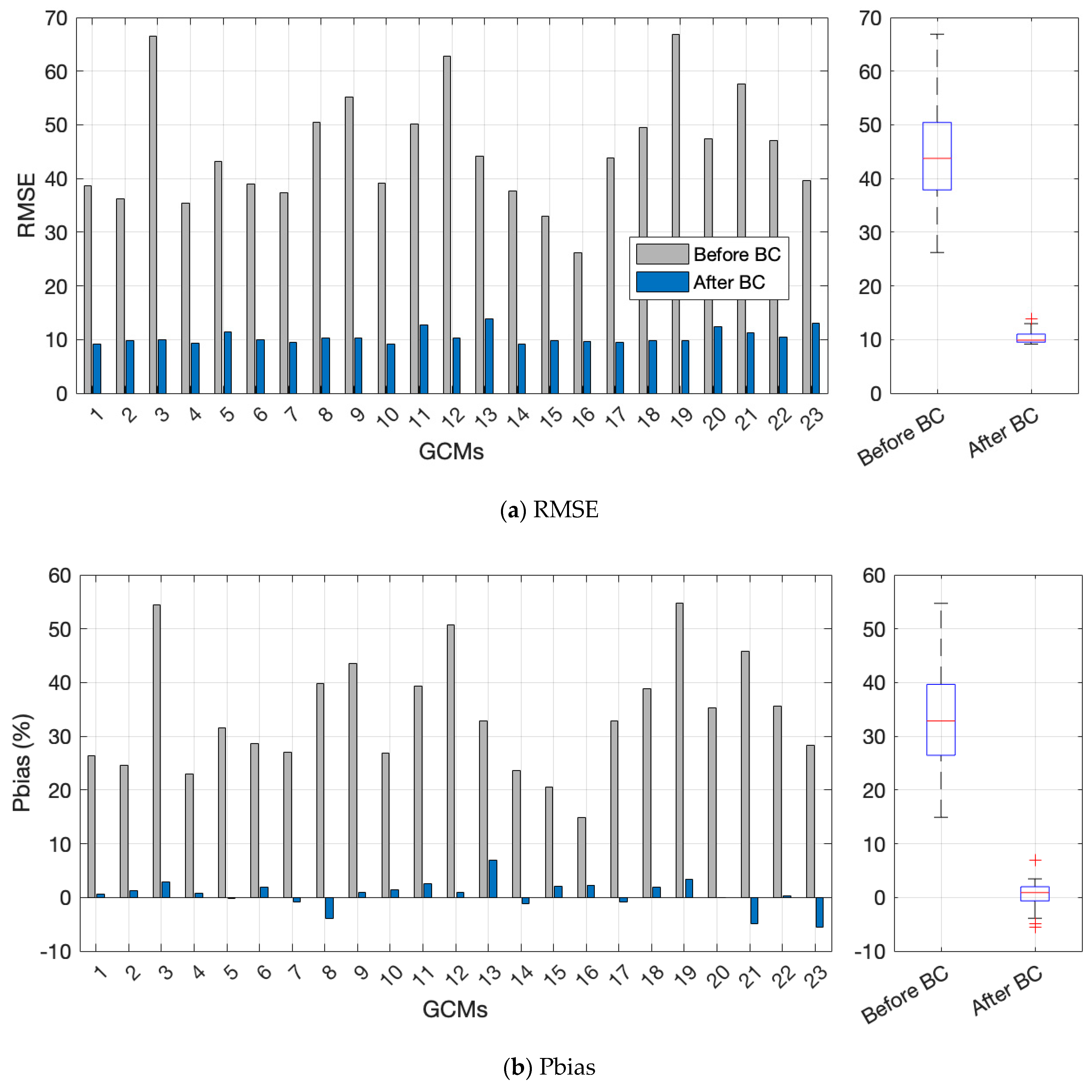
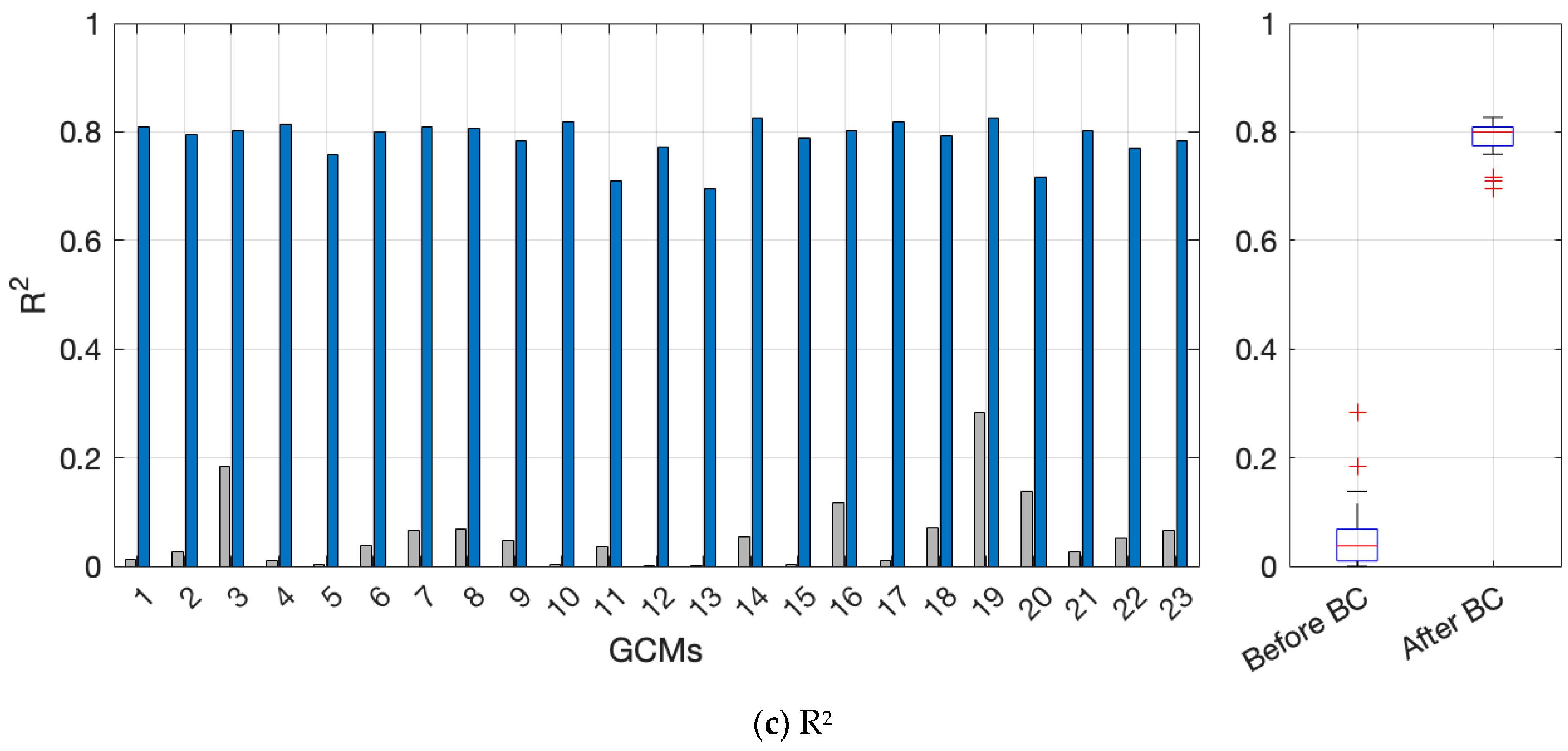


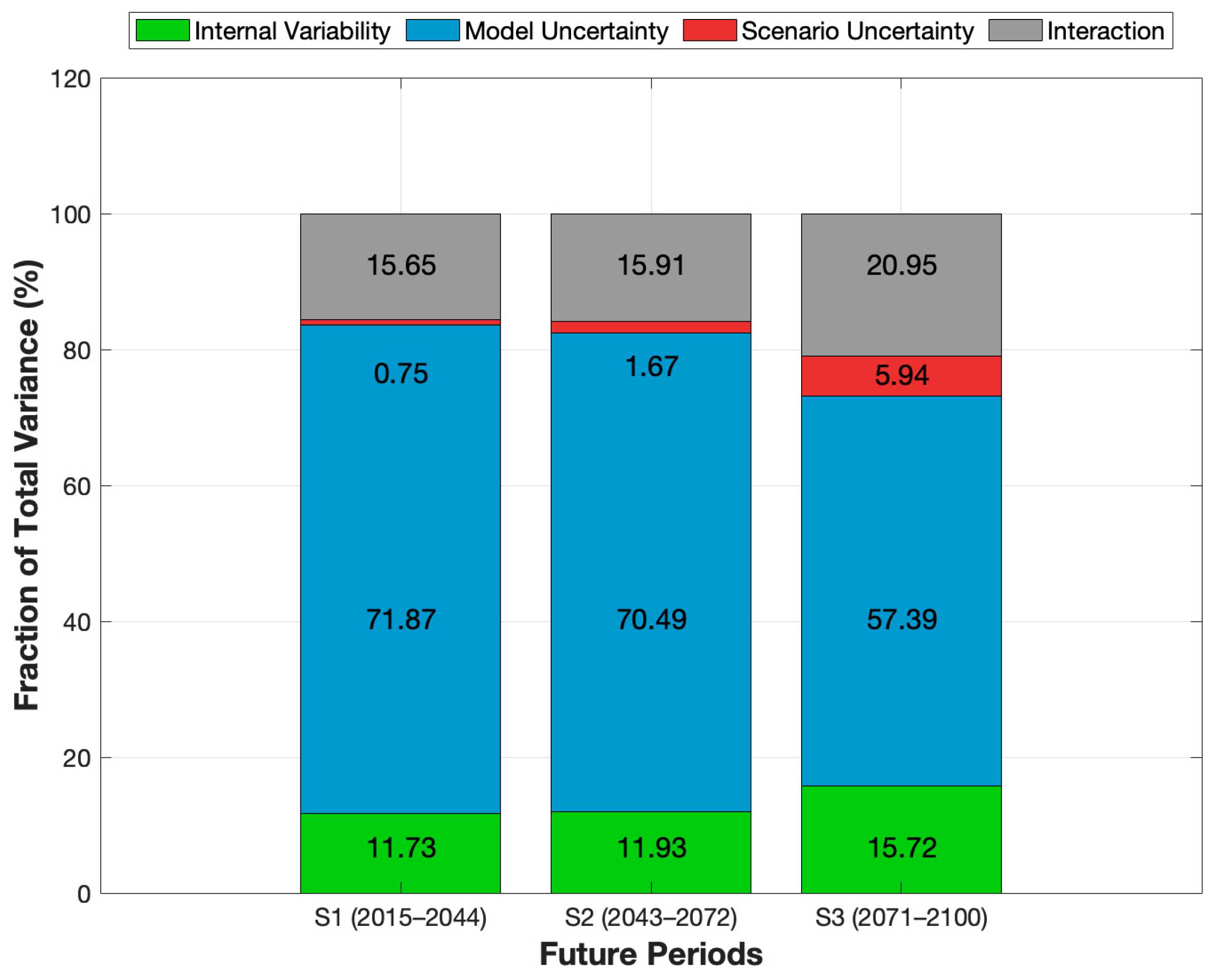
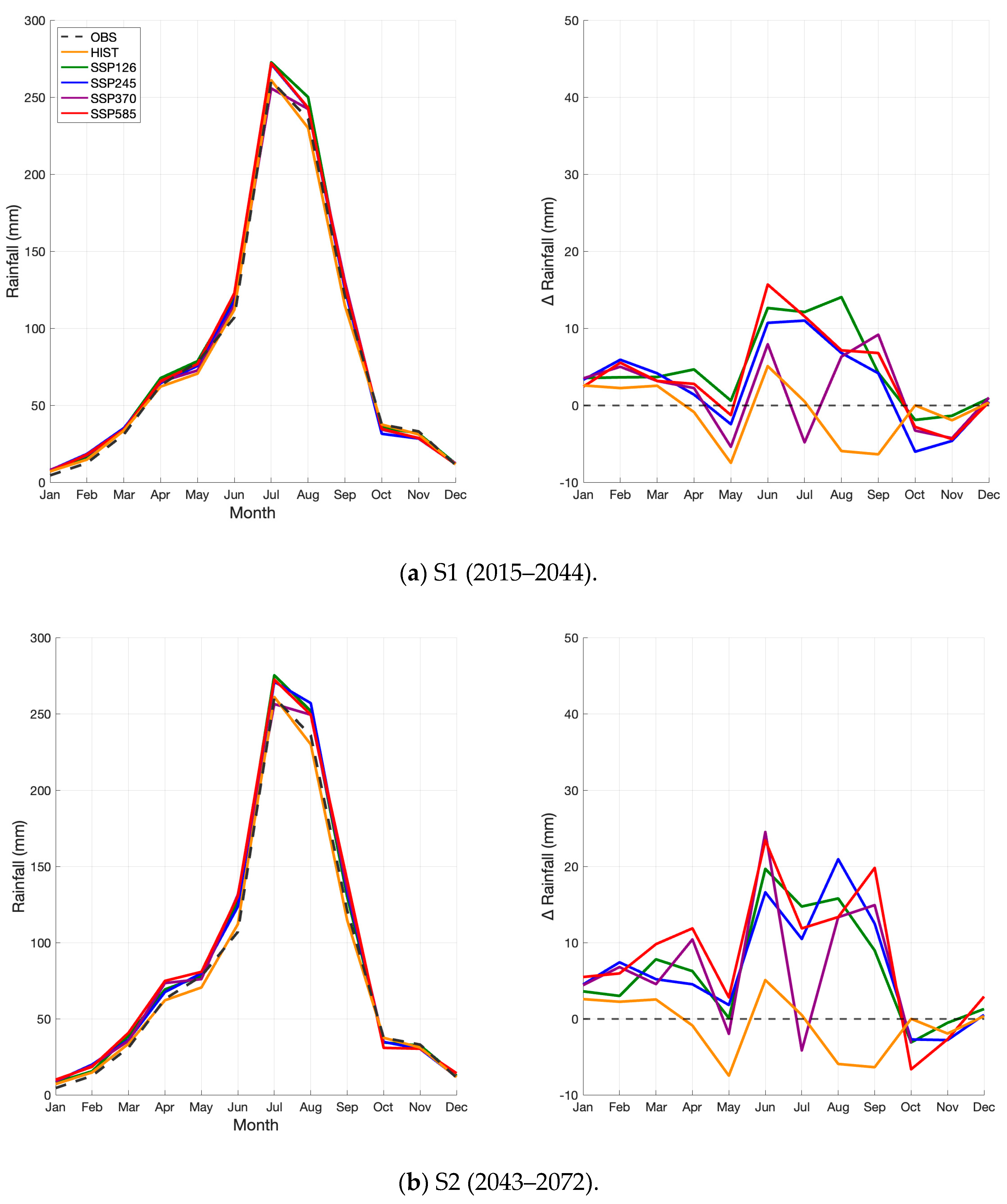



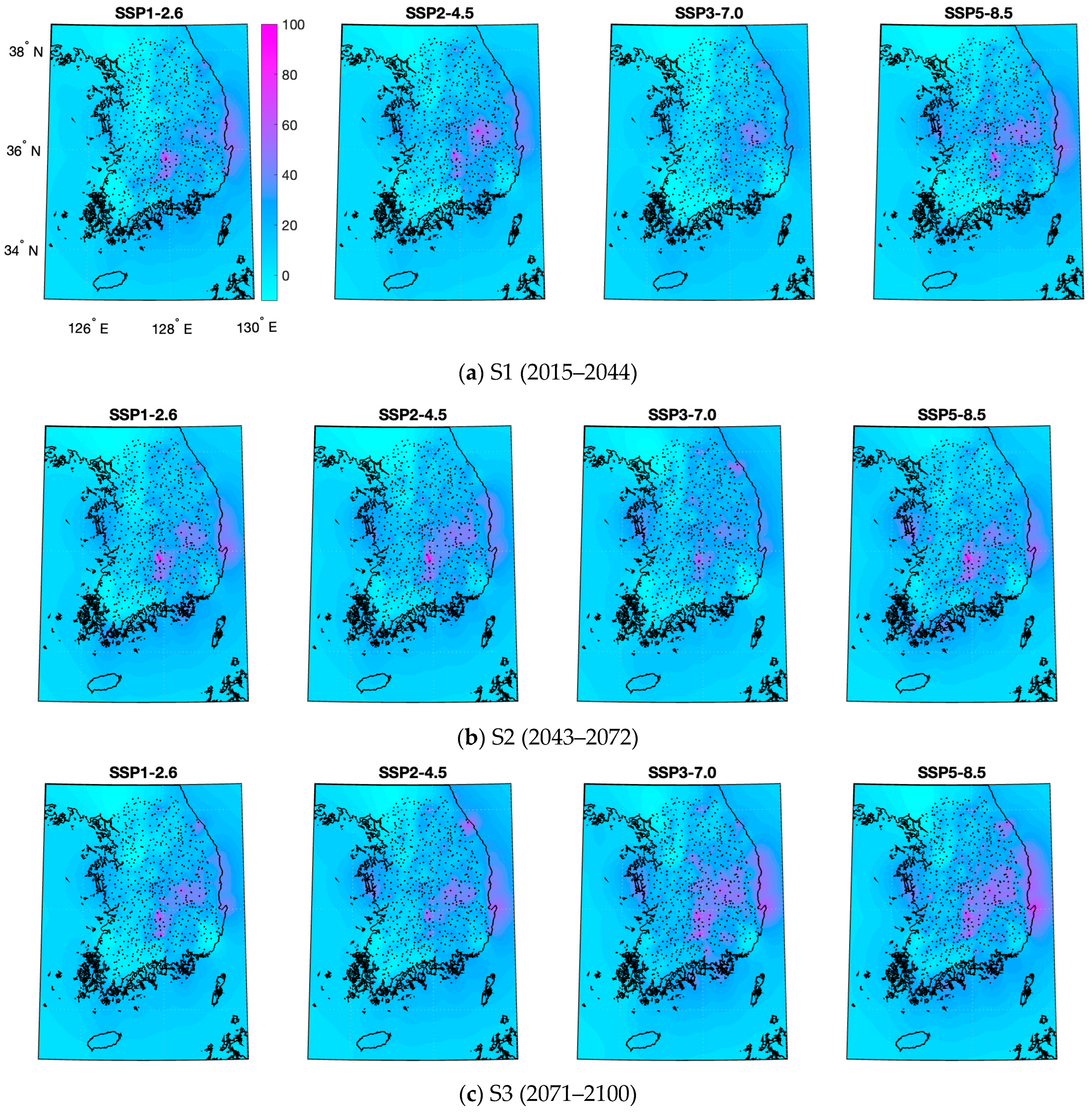
| No. | GCMs | Institution (Nation) | Resolution (km) | Key References |
|---|---|---|---|---|
| 1 | ACCESS-CM2 | CSIRO-ARCCSS (Australia) | 250 | Bi et al. [24] |
| 2 | ACCESS-ESM1-5 | CSIRO-ARCCSS (Australia) | 250 | Ziehn et al. [25] |
| 3 | AWI-CM-1-1-MR | AWI (Germany) | 100 | Semmler et al. [26] |
| 4 | BCC-CSM2-MR | BCC (China) | 250 | Wu et al. [27] |
| 5 | CanESM5 | CCCma (Canada) | 500 | Swart et al. [28] |
| 6 | CMCC-CM2-SR5 | CMCC (Italy) | 100 | Cherchi et al. [29] |
| 7 | CMCC-ESM2 | CMCC (Italy) | 100 | Lovato et al. [30] |
| 8 | EC-Earth3-Veg | EC-Earth-Consortium (Sweden) | 100 | Wyser et al. [31] |
| 9 | EC-Earth3-Veg-LR | EC-Earth-Consortium (Sweden) | 250 | Döscher et al. [32] |
| 10 | FGOALS-g3 | CAS (China) | 250 | Li et al. [33] |
| 11 | GFDL-ESM4 | NOAA-GFDL (USA) | 100 | Held et al. [34] |
| 12 | IITM-ESM | CCCR-IITM (India) | 250 | Swapna et al. [35] |
| 13 | INM-CM4-8 | INM (Russia) | 100 | Volodin et al. [36] |
| 14 | INM-CM5-0 | INM (Russia) | 100 | Volodin et al. [37] |
| 15 | IPSL-CM6A-LR | IPSL (France) | 250 | Lurton et al. [38] |
| 16 | KACE-1-0-G | NIMS-KMA (South Korea) | 250 | Lee et al. [39] |
| 17 | MIROC6 | MIROC (Japan) | 250 | Tatebe et al. [40] |
| 18 | MPI-ESM1-2-HR | MPI-M (Germany) | 100 | Gutjahr et al. [41] |
| 19 | MPI-ESM1-2-LR | MPI-M (Germany) | 250 | Mauritsen et al. [42] |
| 20 | MRI-ESM2-0 | MRI (Japan) | 100 | Yukimoto et al. [43] |
| 21 | NorESM2-LM | NCC (Norway) | 250 | Seland et al. [44] |
| 22 | NorESM2-MM | NCC (Norway) | 100 | Seland et al. [44] |
| 23 | TaiESM1 | AS-RCEC (Taiwan) | 100 | Lee et al. [45] |
Disclaimer/Publisher’s Note: The statements, opinions and data contained in all publications are solely those of the individual author(s) and contributor(s) and not of MDPI and/or the editor(s). MDPI and/or the editor(s) disclaim responsibility for any injury to people or property resulting from any ideas, methods, instructions or products referred to in the content. |
© 2025 by the authors. Licensee MDPI, Basel, Switzerland. This article is an open access article distributed under the terms and conditions of the Creative Commons Attribution (CC BY) license (https://creativecommons.org/licenses/by/4.0/).
Share and Cite
Kim, S.; Shin, J.-Y.; Heo, J.-H. Assessment of Future Rainfall Quantile Changes in South Korea Based on a CMIP6 Multi-Model Ensemble. Water 2025, 17, 894. https://doi.org/10.3390/w17060894
Kim S, Shin J-Y, Heo J-H. Assessment of Future Rainfall Quantile Changes in South Korea Based on a CMIP6 Multi-Model Ensemble. Water. 2025; 17(6):894. https://doi.org/10.3390/w17060894
Chicago/Turabian StyleKim, Sunghun, Ju-Young Shin, and Jun-Haeng Heo. 2025. "Assessment of Future Rainfall Quantile Changes in South Korea Based on a CMIP6 Multi-Model Ensemble" Water 17, no. 6: 894. https://doi.org/10.3390/w17060894
APA StyleKim, S., Shin, J.-Y., & Heo, J.-H. (2025). Assessment of Future Rainfall Quantile Changes in South Korea Based on a CMIP6 Multi-Model Ensemble. Water, 17(6), 894. https://doi.org/10.3390/w17060894





